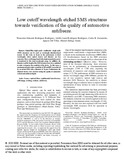Low cutoff wavelength etched SMS structures towards verification of the quality of automotive antifreeze
Fecha
2020Autor
Versión
Acceso abierto / Sarbide irekia
Tipo
Artículo / Artikulua
Versión
Versión aceptada / Onetsi den bertsioa
Identificador del proyecto
ES/1PE/TEC2016-78047-R
Impacto
|
|
10.1109/JSEN.2020.2995610
Resumen
Optical fiber single mode-multimode-single mode (SMS) structures can be used as wavelength detection-based sensors. In this work, we focus on the performance at short wavelengths, where optical sources and detectors are less expensive. Here, a self-image band with a high transmission power is monitored in this short-wavelength range. In addition, the diameter and the length of the SMS structure h ...
[++]
Optical fiber single mode-multimode-single mode (SMS) structures can be used as wavelength detection-based sensors. In this work, we focus on the performance at short wavelengths, where optical sources and detectors are less expensive. Here, a self-image band with a high transmission power is monitored in this short-wavelength range. In addition, the diameter and the length of the SMS structure have been optimized in order to improve the sensitivity of the device. In this sense, a maximum refractive index sensitivity of 305 nm/RIU was achieved by an etched SMS with a diameter of 34μ m. Furthermore, the obtained devices were used for testing the quality of automotive coolant and antifreeze liquid. [--]
Materias
Optical fiber,
Multimodal interference,
Self-image,
Etching,
Coolant,
Antifreeze
Editor
IEEE
Publicado en
IEEE Sensors Journal, 2020, 20(19), 11342-11349
Departamento
Universidad Pública de Navarra. Departamento de Ingeniería Eléctrica, Electrónica y de Comunicación /
Nafarroako Unibertsitate Publikoa. Ingeniaritza Elektrikoa, Elektronikoa eta Telekomunikazio Ingeniaritza Saila
Versión del editor
Entidades Financiadoras
This work was supported in part by the Programa de Fortalecimiento de la Calidad Educativa (PFCE) and the Programa para el Desarrollo Profesional Docente (PRODEP), in part by the Direction of Strategic Programs and Projects of the Autonomus University of Tamaulipas (UAT) and the direction of the Academic Multidisciplinary Reynosa-Rodhe Unit, in part by the Spanish Agencia Estatal de Investigación (AEI) and Fondo Europeo de Desarrollo Regional (FEDER) under Grant TEC2016-78047-R, in part by the Government of Navarra under Grant PC095-096 OPTISENS and Grant PC081-082 BIOPTSENS AVANZA, and in part by the Public University of Navarra under Grant PJUPNA26.





